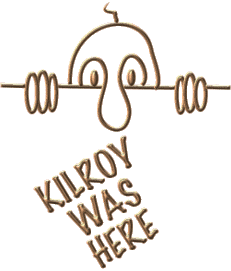 There was one person who led or participated in every combat, training or occupation operation during WWII and the Korean War. This person could always be depended on. GI's began to consider him the "super GI." He was one who always got there first or who was always there when they left. I am, of course, referring to Kilroy Was Here. Somehow, this simple graffiti captured the imagination of GI's everywhere they went. The scribbled cartoon face and words showed up everywhere - worldwide. Stories (some even true) abound. Its origins are unknown, but it is widely speculated that its spread was began by American GIs during World War II.
There was one person who led or participated in every combat, training or occupation operation during WWII and the Korean War. This person could always be depended on. GI's began to consider him the "super GI." He was one who always got there first or who was always there when they left. I am, of course, referring to Kilroy Was Here. Somehow, this simple graffiti captured the imagination of GI's everywhere they went. The scribbled cartoon face and words showed up everywhere - worldwide. Stories (some even true) abound. Its origins are unknown, but it is widely speculated that its spread was began by American GIs during World War II.
Here is one version of its origins:
This Legend of how "Kilroy was here" starts is with James J. Kilroy, a shipyard inspector during WWII. He chalked the words on bulkheads to show that he had been there and inspected the riveting in the newly constructed ship. To the troops in those ships, however, it was a complete mystery — all they knew for sure was that he had "been there first." As a joke, they began placing the graffiti wherever they (the US forces) landed or went, claiming it was already there when they arrived.Here's another version of its origin:
Kilroy became the US super-GI who always got there first — wherever GI's went. It became a challenge to place the logo in the most unlikely places. It was said to be atop Mt. Everest, the Statue of Liberty, the underside of the Arch de Triumphe, and scrawled in the dust on the moon. An outhouse was built for the exclusive use of Truman, Stalin, and Churchill who were there for the Potsdam conference. The first person to use it was Stalin. He emerged and asked his aide (in Russian), "Who is Kilroy?"
WWII UDT (Under Water Demolition - later Navy Seals) divers swam ashore on Japanese held islands in the Pacific to prepare the beaches for the coming landings by US troops. They were sure to be the first GIs there! On more than one occasion, they reported seeing "Kilroy was here" scrawled on make shift signs or as graffiti on enemy pillboxes. They, in turn, often left similar signs for the next incoming GIs.
The tradition continued in every US military theater of operations throughout and following WWII.
In 1946 the Transit Company of America held a contest offering a prize of a real trolley car to the person who could prove himself to be the "real" Kilroy. Almost forty men stepped forward to make that claim, but James Kilroy brought along officials from the shipyard and some of the riveters to help prove his authenticity. James Kilroy won the prize of the trolley car which he gave it to his nine children as a Christmas gift and set it up in their front yard for a playhouse.
The way I understand it, Kilroy was an Admiral during WWII. During an inspection of the fleet he noticed that bolts on the ship had seven or more threads extended from the nuts. When he saw this he issued orders to cut the bolts to a maximum of three threads. This resulted in saving tons of metal for other uses during the war. Thereafter, when GIs went aboard a ship and saw that the bolts had been cut down to three exposed threads, they knew Kilroy had been there - "Kilroy Was Here." I hope this information with assist in finding out where Kilroy came from before he "was here."Here's another account:
During WWII we were turning out Liberty ships very fast and of course they all had to be inspected. Plumbing inspections, electrical inspections, etc, etc. There was one inspector named Mr. Kilroy working in a shipyard in Boston. Upon completion of his inspection tour, if the proper people and papers were not there for him to sign he would just scrawl on the bulkhead "Kilroy was here" And then move on to his next inspection. That was the sign that he was there, inspected and passed the ship. Most of the ships were built so fast that not all surfaces had time to be painted and thousands of soldiers saw his little notes on the bulkheads. That's how "Kilroy was here" got it's start. If not, at least it is a good story.That's a whole of information about something you probably didn't care about in the first place. Read more explanations here.




0 comments:
Post a Comment